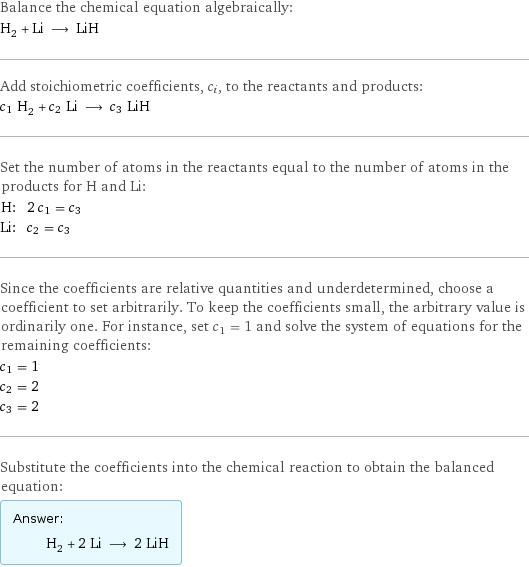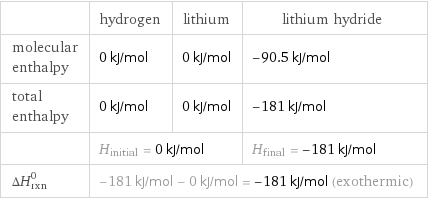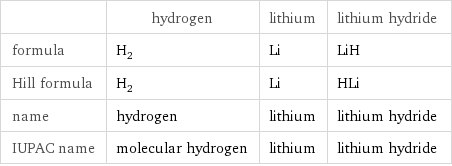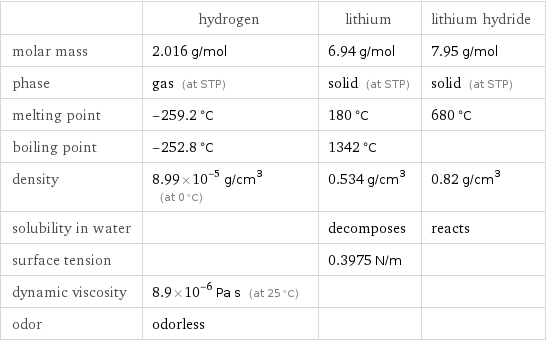Input interpretation

H_2 (hydrogen) + Li (lithium) ⟶ LiH (lithium hydride)
Balanced equation

Balance the chemical equation algebraically: H_2 + Li ⟶ LiH Add stoichiometric coefficients, c_i, to the reactants and products: c_1 H_2 + c_2 Li ⟶ c_3 LiH Set the number of atoms in the reactants equal to the number of atoms in the products for H and Li: H: | 2 c_1 = c_3 Li: | c_2 = c_3 Since the coefficients are relative quantities and underdetermined, choose a coefficient to set arbitrarily. To keep the coefficients small, the arbitrary value is ordinarily one. For instance, set c_1 = 1 and solve the system of equations for the remaining coefficients: c_1 = 1 c_2 = 2 c_3 = 2 Substitute the coefficients into the chemical reaction to obtain the balanced equation: Answer: | | H_2 + 2 Li ⟶ 2 LiH
Structures

+ ⟶
Names

hydrogen + lithium ⟶ lithium hydride
Reaction thermodynamics
Enthalpy

| hydrogen | lithium | lithium hydride molecular enthalpy | 0 kJ/mol | 0 kJ/mol | -90.5 kJ/mol total enthalpy | 0 kJ/mol | 0 kJ/mol | -181 kJ/mol | H_initial = 0 kJ/mol | | H_final = -181 kJ/mol ΔH_rxn^0 | -181 kJ/mol - 0 kJ/mol = -181 kJ/mol (exothermic) | |
Equilibrium constant
![Construct the equilibrium constant, K, expression for: H_2 + Li ⟶ LiH Plan: • Balance the chemical equation. • Determine the stoichiometric numbers. • Assemble the activity expression for each chemical species. • Use the activity expressions to build the equilibrium constant expression. Write the balanced chemical equation: H_2 + 2 Li ⟶ 2 LiH Assign stoichiometric numbers, ν_i, using the stoichiometric coefficients, c_i, from the balanced chemical equation in the following manner: ν_i = -c_i for reactants and ν_i = c_i for products: chemical species | c_i | ν_i H_2 | 1 | -1 Li | 2 | -2 LiH | 2 | 2 Assemble the activity expressions accounting for the state of matter and ν_i: chemical species | c_i | ν_i | activity expression H_2 | 1 | -1 | ([H2])^(-1) Li | 2 | -2 | ([Li])^(-2) LiH | 2 | 2 | ([LiH])^2 The equilibrium constant symbol in the concentration basis is: K_c Mulitply the activity expressions to arrive at the K_c expression: Answer: | | K_c = ([H2])^(-1) ([Li])^(-2) ([LiH])^2 = ([LiH])^2/([H2] ([Li])^2)](../image_source/05b9b6347c362c492afd89b4e4344969.png)
Construct the equilibrium constant, K, expression for: H_2 + Li ⟶ LiH Plan: • Balance the chemical equation. • Determine the stoichiometric numbers. • Assemble the activity expression for each chemical species. • Use the activity expressions to build the equilibrium constant expression. Write the balanced chemical equation: H_2 + 2 Li ⟶ 2 LiH Assign stoichiometric numbers, ν_i, using the stoichiometric coefficients, c_i, from the balanced chemical equation in the following manner: ν_i = -c_i for reactants and ν_i = c_i for products: chemical species | c_i | ν_i H_2 | 1 | -1 Li | 2 | -2 LiH | 2 | 2 Assemble the activity expressions accounting for the state of matter and ν_i: chemical species | c_i | ν_i | activity expression H_2 | 1 | -1 | ([H2])^(-1) Li | 2 | -2 | ([Li])^(-2) LiH | 2 | 2 | ([LiH])^2 The equilibrium constant symbol in the concentration basis is: K_c Mulitply the activity expressions to arrive at the K_c expression: Answer: | | K_c = ([H2])^(-1) ([Li])^(-2) ([LiH])^2 = ([LiH])^2/([H2] ([Li])^2)
Rate of reaction
![Construct the rate of reaction expression for: H_2 + Li ⟶ LiH Plan: • Balance the chemical equation. • Determine the stoichiometric numbers. • Assemble the rate term for each chemical species. • Write the rate of reaction expression. Write the balanced chemical equation: H_2 + 2 Li ⟶ 2 LiH Assign stoichiometric numbers, ν_i, using the stoichiometric coefficients, c_i, from the balanced chemical equation in the following manner: ν_i = -c_i for reactants and ν_i = c_i for products: chemical species | c_i | ν_i H_2 | 1 | -1 Li | 2 | -2 LiH | 2 | 2 The rate term for each chemical species, B_i, is 1/ν_i(Δ[B_i])/(Δt) where [B_i] is the amount concentration and t is time: chemical species | c_i | ν_i | rate term H_2 | 1 | -1 | -(Δ[H2])/(Δt) Li | 2 | -2 | -1/2 (Δ[Li])/(Δt) LiH | 2 | 2 | 1/2 (Δ[LiH])/(Δt) (for infinitesimal rate of change, replace Δ with d) Set the rate terms equal to each other to arrive at the rate expression: Answer: | | rate = -(Δ[H2])/(Δt) = -1/2 (Δ[Li])/(Δt) = 1/2 (Δ[LiH])/(Δt) (assuming constant volume and no accumulation of intermediates or side products)](../image_source/7bce533952cb048d8395434749e6e807.png)
Construct the rate of reaction expression for: H_2 + Li ⟶ LiH Plan: • Balance the chemical equation. • Determine the stoichiometric numbers. • Assemble the rate term for each chemical species. • Write the rate of reaction expression. Write the balanced chemical equation: H_2 + 2 Li ⟶ 2 LiH Assign stoichiometric numbers, ν_i, using the stoichiometric coefficients, c_i, from the balanced chemical equation in the following manner: ν_i = -c_i for reactants and ν_i = c_i for products: chemical species | c_i | ν_i H_2 | 1 | -1 Li | 2 | -2 LiH | 2 | 2 The rate term for each chemical species, B_i, is 1/ν_i(Δ[B_i])/(Δt) where [B_i] is the amount concentration and t is time: chemical species | c_i | ν_i | rate term H_2 | 1 | -1 | -(Δ[H2])/(Δt) Li | 2 | -2 | -1/2 (Δ[Li])/(Δt) LiH | 2 | 2 | 1/2 (Δ[LiH])/(Δt) (for infinitesimal rate of change, replace Δ with d) Set the rate terms equal to each other to arrive at the rate expression: Answer: | | rate = -(Δ[H2])/(Δt) = -1/2 (Δ[Li])/(Δt) = 1/2 (Δ[LiH])/(Δt) (assuming constant volume and no accumulation of intermediates or side products)
Chemical names and formulas

| hydrogen | lithium | lithium hydride formula | H_2 | Li | LiH Hill formula | H_2 | Li | HLi name | hydrogen | lithium | lithium hydride IUPAC name | molecular hydrogen | lithium | lithium hydride
Substance properties

| hydrogen | lithium | lithium hydride molar mass | 2.016 g/mol | 6.94 g/mol | 7.95 g/mol phase | gas (at STP) | solid (at STP) | solid (at STP) melting point | -259.2 °C | 180 °C | 680 °C boiling point | -252.8 °C | 1342 °C | density | 8.99×10^-5 g/cm^3 (at 0 °C) | 0.534 g/cm^3 | 0.82 g/cm^3 solubility in water | | decomposes | reacts surface tension | | 0.3975 N/m | dynamic viscosity | 8.9×10^-6 Pa s (at 25 °C) | | odor | odorless | |
Units
